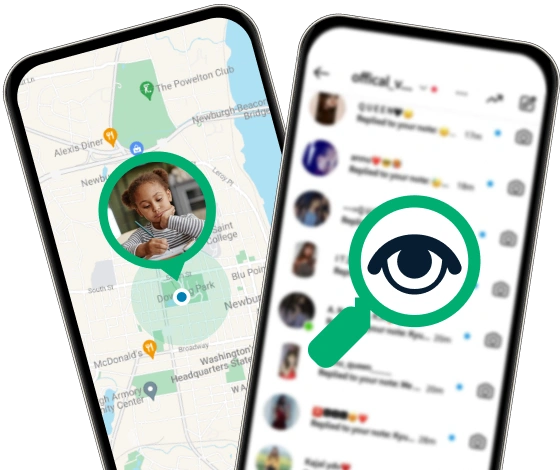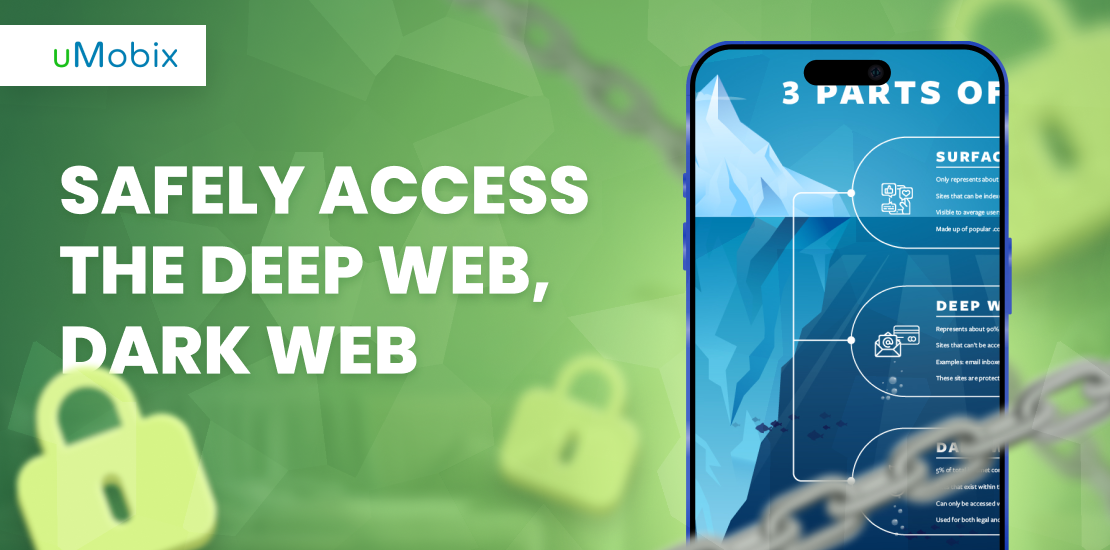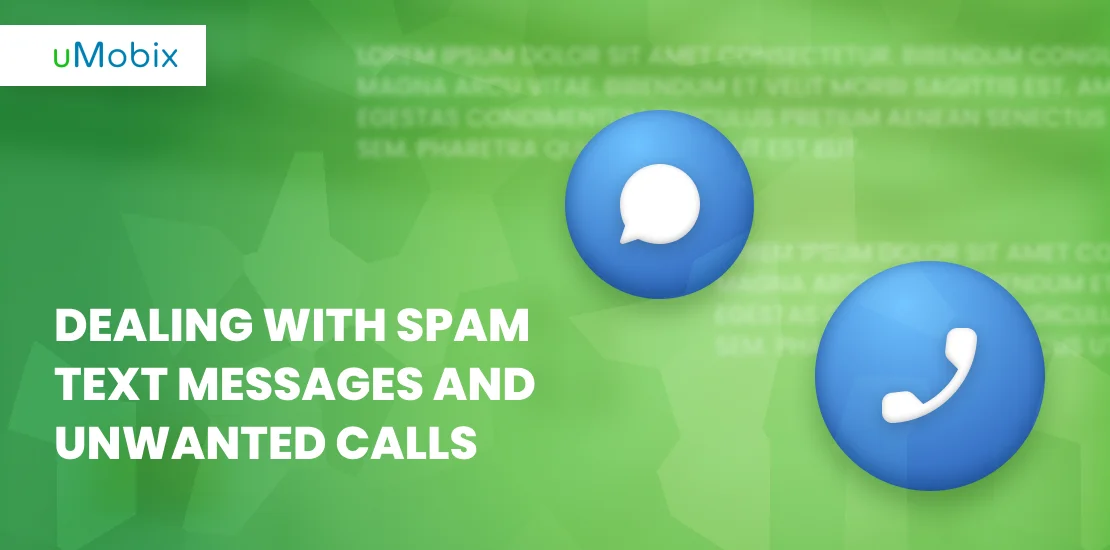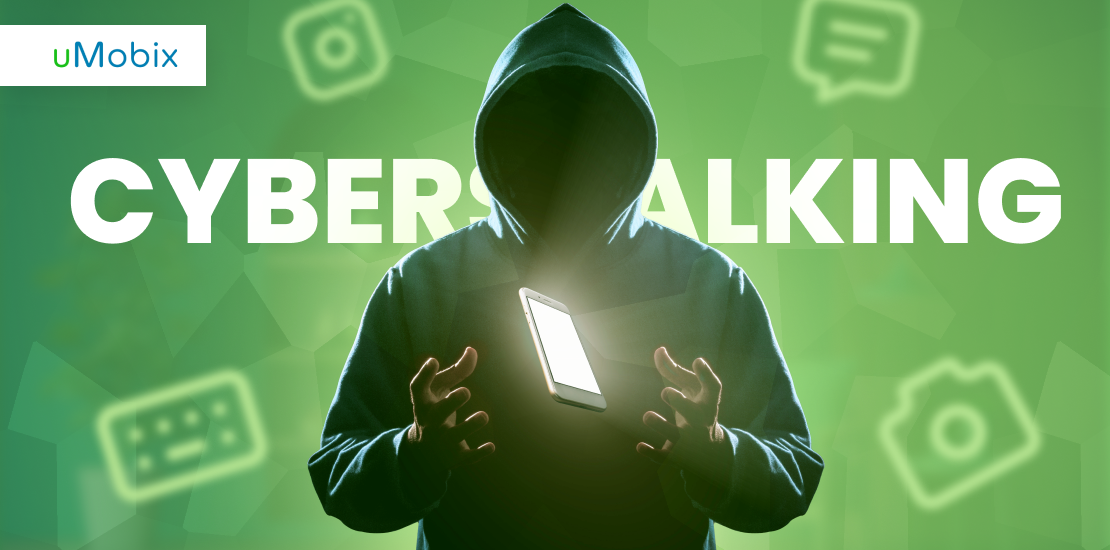The Internet is a sprawling universe filled with various websites and information available for quick and easy access. However, the fact is that the Internet is deeper than you can imagine, and beneath its surface lies a hidden world that most people have never seen – the dark web. So, what is the dark web? Although it may sound as scary as dark matter, for some people, it represents a place of freedom and anonymity where the usual rules do not apply.
In this shadow realm, people often look for information, communities, and resources censored or restricted on the surface web. It is a place where people can find everything from restricted goods to illegal currency – all traded away from the watchful eyes of law enforcement. In other words, the dark side of the Internet is the hidden side, where each click can take you to an unknown.
Being experts in online safety and security, the uMobix team has prepared this article to tell you more about the dark web meaning, what it is used for, and what dangers are associated with its use. We will tell you who created the dark web and the dangers it comes with, especially for kids. Have you found your data there? Do you want to know how to remove your information from the dark web? Don’t worry. uMobix offers a reliable solution to remove it. So, keep on reading to get the answers.
What Is the Dark Web and How Does It Work?
Before we start, let’s first provide you with information on the dark web meaning, how it appeared and when it was created.
Dark Web Meaning
So, what is the dark web and how does it work? The dark web, according to the National Library of Medicine, is a hidden part of the Internet that is hosted on websites whose IP address is hidden and is not indexed by regular search engines. The information on the dark web can only be accessed if special software is used. The dark web consists of private content shared among users on closed computer networks known as darknets. These networks are not open to the public, making the information shared there more secretive.
Who Created the Dark Web?
A single person did not create the dark web. It has been developed over time by different technologies and techniques to enhance online privacy and anonymity. However, Tor, the heart of the dark web, was developed by a group of researchers in the U.S. Naval Research Laboratory in the late 1990s and officially launched on 20 September 2002.
When Was the Dark Web Created?
The term dark web emerged in 2009. The first significant development was the creation of The Onion Router (Tor) in 2002, designed to provide anonymity online. Before Tor, there were already attempts to make secure communication networks. Since then, the dark web has grown into a space where people can access hidden content and communicate without being easily tracked.
What Is the Dark Web Used for? What Can You Find There?
Most cybercriminals and other malicious individuals rely on the dark web in different unlawful ways. The main places for illegal activity on the dark web are marketplaces and forums where people buy and sell illegal products and services.
So, what is the dark web used for? The dark web is used for various purposes, both legal and illegal. Here are some of the common uses and types of content you can find there:
- Restricted content: People frequently go to the dark web to find blocked or censored content that cannot be accessed on the surface web.
- Private data shared openly: Politicians, journalists, and other individuals cannot share their private information on the surface web. So, they do it on the dark web without fear of being judged or traced.
- Anonymity in communication: Many people use the dark web to keep their identity safe and communicate privately. This is especially important in countries where the government closely monitors online activity and restricts access to information.
What content can be found on the dark web? Criminals and scammers sell various illegal products on these black markets, including stolen and fake data, which can include:
- Personally identifiable information: Also known as PII, it includes full names, home addresses, cell phone numbers, SSNs (Social Security numbers), dates of birth, and other data that can identify you as an individual.
- Financial data: Online banking usernames and passwords, stolen credit card data, credentials for cryptocurrency accounts, etc.
- Online accounts login info: These often include combinations of usernames and passwords that give access to various accounts, such as social media, video streaming services, paid professional services, etc.
- Medical information: All the information about your health condition can be found on the dark web. It involves your prescriptions, diagnosis, test results, billing info, and other private data.
- Stolen/lost data: Stolen, lost, or forgotten login credentials, driver licenses, and IDs.
- Extreme content: Explicit online content and graphic material, including violence or illegal pornography.
- Hacking services or tools: Special tools such as tutorials or paid services to hack into systems.
Types of Web Layers: What Is the Difference?
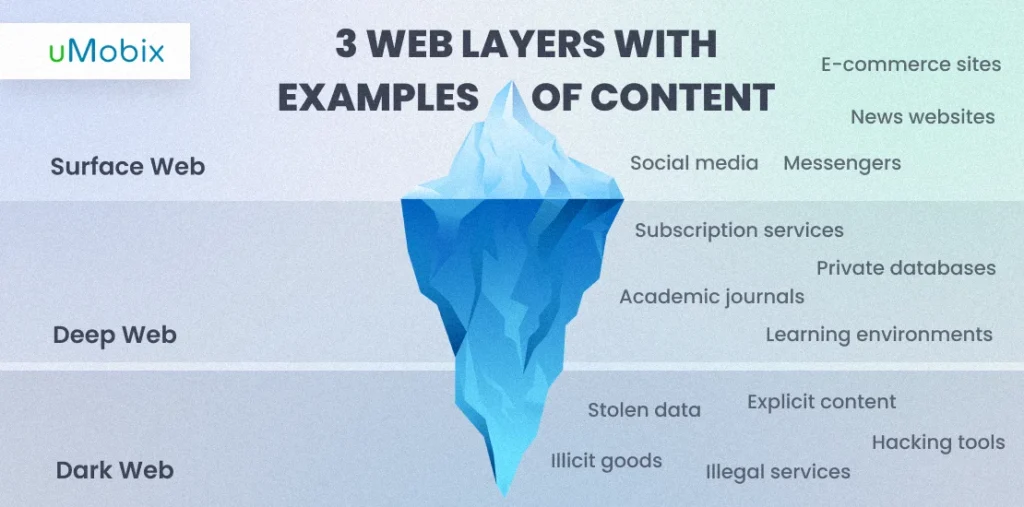
Like an iceberg, the Internet can be divided into three levels: the surface, the deep web, and the dark web. Each layer has its characteristic features and the auditory it provides access to. So, let’s look at each of them in more detail.
Surface Web
The Surface Web describes websites you visit through Google, Yahoo, Bing, and other major web browsers. In short, the Surface Web is the public side of the Internet. The best way to describe it is that it’s the tip of the iceberg. While the Surface Web seems vast, there’s a much deeper surface hiding underneath. It’s estimated that 4% of the Internet is only the Surface Web. So, despite it making up a minority of the Internet, it’s what most users see.
Here are some examples of content you can find on the surface web:
- Free access videos: These are on popular social media sites like YouTube and online communications platforms like TikTok.
- Social media, IM, and online dating apps: Access to social media apps like Instagram, Facebook, Telegram, Tinder, etc.
- News websites: CNN, BBC, and The New York Times.
- E-commerce sites: Online stores such as Amazon, AliExpress, Temu, or eBay.
Deep Web
The Deep Web consists of pages that a search engine cannot find. Sometimes, this is due to the page having no SEO to see it or the website owner not wanting anyone to find it. Sometimes, the Deep Web can be a page in a website that’s visible through a search engine, but the page itself is not. It’s said that 96% of the web’s content is the deep web.
You’ll likely run into a Wild West worth of content on the Deep Web. From Easter eggs to hidden pages, there is a lot to find. However, the Deep Web is different from the Dark Web.
One way you can access the Deep Web is through the Internet Archive, which is designed to archive web pages and past versions. In addition, there are many browsers specifically for the Deep Web, many of which go hand in hand with the Dark Web.
Here are some examples of content you can find on the deep web:
- Content requiring payment or registration to access: Digital newspaper, film, book, etc.
- Academic journals: Research papers and scholarly articles not indexed by search engines.
- Learning environments: E.g., Canvas.
- Private databases: Information from government databases, financial records, and legal documents.
Dark Web
Chances are, you do know what the Dark Web is. The Dark Web, also known as the Black Web, is a portion of the Internet comprising illegal marketplaces and other reasons for being anonymous. People tend to associate the Dark Web with illicit drugs, porn, child exploitation, scams, identity thefts, etc. However, not everything there is illegal.
Here are some examples of content you can find on the dark web:
- Stolen data: Login credentials, lost passports, credit card information, etc.
- Illicit goods: Drugs, weapons, and counterfeit money.
- Explicit content: Graphic material, pornography, and other restricted content.
- Hacking tools: Various tools to hack accounts or sites.
- Illegal services: Fake IDs, passports, etc.
Is the Dark Web Dangerous?
With so much information the hidden web offers, is the dark web dangerous? What should you know about its use? Is the dark web illegal? These and the other important points are discussed below.
Dark Web Dangers for You and Your Kids
Well, what are the dangers the dark web hides? What are the risks for you and your kid?
- You risk your freedom: When buying a gun, drugs, or pornography, you risk your freedom as you can face steep legal action.
- Risk of device infection: If you don’t have strong cybersecurity protection, visiting the dark web can put your devices at risk of getting infected with harmful software like malware, ransomware, and trojan viruses.
- Identity theft: When compared with browsing on the surface web, browsers such as Opera, Firefox, or Google Chrome tell you about the malicious websites that can steal your private information in phishing attacks. The dark web does not provide this level of security.
- Legal consequences: Because the dark web is used for illegal activities, you might be tricked into a scam or accidentally get involved in a crime. This could lead to legal consequences.
- Exposure to explicit content: Kids may come across disturbing or illegal material, such as drugs, weapons, or harmful content, which can harm them emotionally.
- Grooming: Predators may try to target and manipulate children through anonymous platforms, posing a serious safety risk.
- Involvement in illegal activities: Kids might accidentally get involved in illegal activities, like buying fake products or interacting with hackers, without even realizing it.
Is the Dark Web Illegal?
Despite its scary name, access to the dark web is not considered to be illegal. However, malicious actions many people take are really illegal.
How Do Cybercriminals Make Money on the Dark Web?
Here are the most popular methods cybercriminals use to monetize the dark web:
- Use stolen data for all types of identity and financial theft.
- Sell stolen usernames and passwords for profit.
- Infect devices with malware to demand payment for unlocking data.
- Using financial data for different unlawful financial operations.
- They apply extortion – threaten to leak sensitive information unless paid.
- Attack organizations to damage their reputation and cause financial loss.
- Trick reputable companies or steal intellectual property to sell it to their competitors.
Stolen data cybercriminals obtain can easily be sold for a few dollars. Here is some sort of private information cybercriminals sell on the dark web:
- Credit card details: For credit cards with a balance up to $1K, you will pay $150.
- Online banking logging: For an account with less than $100, you will pay $40.
- Fake passport: This service will cost you $4K.
- DDoS services: Attacks that overwhelm systems and take them offline.
- Malicious software: Users can easily get their ransomware and spyware.
- Cybercriminal training: You can find tutorials and guides for learning illegal hacking skills.
- Exploit kits: Different tools are also sold there to find system vulnerabilities and spread malware.
- Malware-as-a-service: A subscription service for renting hacking tools, networks, and support is also available there.
- Money laundering services: Methods to turn stolen money into clean, untraceable cash.
- Botnet access: Networks of compromised devices used for attacks.
How to Find Out If My Information Is on the Dark Web?
Do you suspect your personal data may have been placed on the dark web, or do you simply want to check that hackers did not steal your sensitive information? How to find out if my information is on the dark web? Follow these steps:
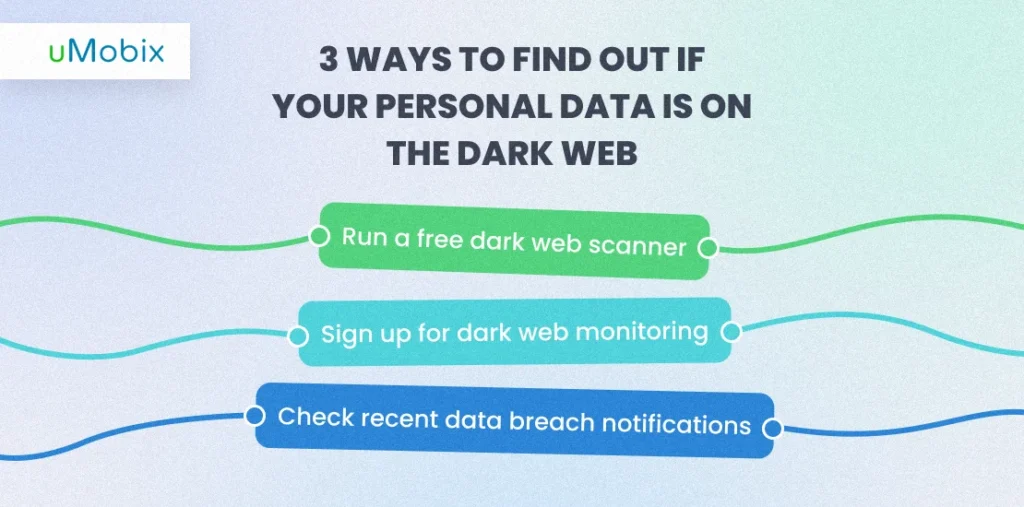
Run a Free Dark Web Scanner
Free dark web scanner is quite a good assistant if you want to access password leaks related to your email address. This tool analyzes databases and looks for stolen credentials, offering info about where and when the data leak occurred. So, if your email address is detected in a leak, the scanner notifies you, allowing you to update passwords and protect your online presence more effectively.
Here’s how to get started with a free dark web scanner:
- Research to find a reliable free dark web scanner. The most popular out there is Have I Been Pwned.
- Enter your email address and press the button to start scanning.
- Once the scan is complete, it will show whether your email address has been found in any data breaches.
- Sign Up for Dark Web Monitoring
Compared with the dark web scanner, dark web monitoring constantly checks the dark web for your private information so that your sensitive data will work around the clock, constantly searching for potential data leaks. You will get an immediate notification when someone tries to access it, allowing you to quickly respond, secure your accounts, and protect your privacy.
Which dark web monitoring service to try?
- LastPass: It is a great and widely used tool for storing all your passwords in one place. It can keep an eye on the dark web for your email addresses and let you know if any accounts are compromised.
- Dashlane: Dashlane is a password manager checking the dark web for you. It scans over 20 billion records to see if your email addresses have been leaked.
- Check Recent Data Breach Notifications
Even the largest organizations in the world, like Microsoft and Amazon, have fallen victim to data breaches. While it’s nearly impossible to keep track of every cyberattack or data leak, you can stay informed about the most significant incidents by following trusted and reliable sources.
How to check the recent data breaches?
- Almost all states are required to notify consumers about data breaches involving personal information. So, you will be informed by email if sensitive data leaks.
- Reading useful and truthful articles, news sites, etc., can also help you stay up to date with the latest updates concerning cybersecurity issues and data leaks.
- Regularly check press releases of government agencies such as the Federal Trade Commission (FTC) and the Cybersecurity and Infrastructure Security Agency (CISA).
How to Remove Your Information from the Dark Web?
The bad news is that removing your information from the dark web is almost impossible. Why? Even if you managed to do it, you would not know who had viewed it, recorded it, or saved it elsewhere. You could worsen things even if you decide to access the dark web alone. You might accidentally download malware onto your device, fall for scams, or expose even more of your personal information.
Nevertheless, there are a few recommendations for you to follow if you detect your data leak.
- Use the dark web scanners or dark web monitoring tools to get notifications in case of sensitive data leaks.
- If your information is exposed, immediately change your accounts’ passwords. Never use the same password twice.
- According to the FTC, you can freeze access to your credit score. This prevents new accounts from being opened in your name. You can still apply for jobs and apartments, but no one will be able to view your credit score.
- If you lose your driver’s license, report it to your state’s Department (or Bureau) of Motor Vehicles.
- If you lose your passport, report it to the U.S. Department of State, Bureau of Consular Affairs.
How to Access the Dark Web Safely
So, how can you access the dark web safely? Here are the best options offered:
- Tor. Using Tor is the best among the dark web search engines, as it protects you while browsing. Not only that, but you can also use Tor to access all the other parts of the web. Never download it from a suspicious website, as it may be there to steal your data. Have all security protection methods cranked as high as you can. Tor filters your activity through its network, but in addition to that, you should ensure extra protection for yourself.
- I2P Anonymous Network. The I2P network is more decentralized than Tor, but it still uses some tools to manage the network and collect statistics. I2P uses a method called garlic routing, which is different from Tor’s onion routing. In onion routing, a message is sent as a single unit, while in garlic routing, the message is split into encrypted parts.
- Freenet. It will allow you to browse the Internet anonymously, keeping your private data safe from being tracked. It is decentralized, so there isn’t a central server that can be turned off or censored, making it tough for attackers to disrupt the network or block access. Even with all the precautions, we should mention that going on the dark web is risky. So be mindful of that, and never give away information that can expose you.
How to Protect Yourself and Your Kids Online?
With all that mentioned, how can you protect yourself and your kid when navigating online? Let’s break it down.
uMobix Parental Control Tool
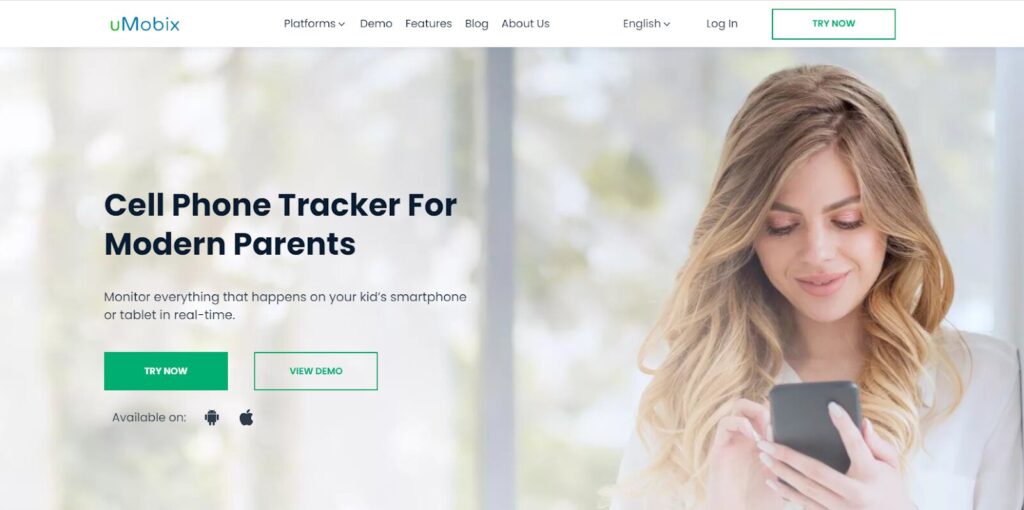
uMobix is the #1 tool when the focus point is your or your kid’s online safety. The app has all you need for safe and secure online navigation. Right after this parental control app installation on your kid’s phone, you will be able to:
- Get access to their web browser history
- View sites they visit and block them in case you find them harmful
- View what content your kid views at the moment or what files they share with other users
- Get access to all the text messages that were blocked – especially useful in case a hacker gets access to your accounts and deletes a text message when the system sends you a notification about unusual activity
The app is easy to use and has a detailed installation guide for Android or iOS devices. The support team is very friendly and professional, always ready to respond to any product-related issue. The best part? You can test the app for only a dollar, try its features, and see how it looks inside.
VPN and Antivirus
VPNs (Virtual Private Networks) and antivirus software are key tools for keeping you and your child safe online. A VPN hides your internet activity by encrypting your data so hackers and internet providers can’t see what you’re doing. It keeps your child’s browsing private, letting them browse the Internet without revealing their data. Plus, VPNs allow access to restricted content, making it easier for kids to find helpful educational resources.
Antivirus software is a must-have for a safe and protected online experience. It protects devices by finding and removing harmful programs or malware. Many antivirus programs also include parental controls so parents can monitor and limit their kids’ online activities.
If used together, VPNs and antivirus software help create a safer online experience for everyone.
Do Not Overshare on Social Networks
Personal data oversharing on social networks can also risk your or your kid’s data. When people share too much personal information, like their location or daily activities, they can attract unwanted attention or even face cyberbullying. Therefore, it is important to think carefully about what to post online and to set clear rules about sharing personal details.
Final Words
The dark web is not only a place where people can access any information but also one of the most dangerous places where one risks becoming a victim of hackers who can easily get access to your data and then share it with others, sell it, or what’s worse use it for illegal activities. Therefore, being careful when navigating online is the #1 priority for everyone. So, using the tips and tricks mentioned in this review along with a reliable tool like uMobix, you will be able to protect yourself and your dearest and nearest from this kind of threat.
FAQ
Many dark web links are not accessible via a standard browser. Instead, you need to download the Tor browser, allowing you to surf the dark web. Tor is also available on another web 3.0 browser such as Brave. When accessing the dark web, ensure your security settings are as high as possible. This way, you avoid any dangers that come your way.
The dark web is filled with black markets and illegal content. Not only that, but it is filled with malware, hackers, and bad actors looking to scam you. It’s also prone to government spying.
Because of all this, you do not want to go into the dark web without protection. Tor is the safest browser, and you can play with its security settings to ensure a safer browsing experience. Never go into the dark web without at least some kind of protection because it will end badly.
The dark web is a grab bag of various websites. As you may assume, there are black market websites that are illegal to use. However, you can find traditional websites on the dark web, such as chat rooms, social media, photo-sharing sites, and more. Some dark web users only browse the dark web to be anonymous and away from a web controlled by big tech websites.
Tor uses onion routing, which is why many websites on the dark web have the word onion in them. Onion routing uses P2P or peer-to-peer technology. In addition, Tor uses multiple encryption layers to browse safely, meaning you can visit the dark web without much worry about who is watching you.
